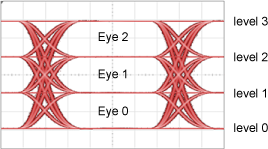PAM Levels
Instrument
N1000A
N109x
Flex Apps:
FlexDCA
Meas. mode:
Eye
Package License:
L-RND
L-MFG
Waveform type:
PAM
 The Eye mode PAM Levels measurement measures all four amplitude levels (0, 1, 2, 3) of a PAM4 eye diagram.
The Eye mode PAM Levels measurement measures all four amplitude levels (0, 1, 2, 3) of a PAM4 eye diagram.
| Setting | Description |
|---|---|
| PAM-N Analysis Setup Dialog Settings | |
| Receiver Sample Timing | Configures the timing for sampling the signal data for all PAM measurements in Eye/Mask mode. Depending on measurement conditions, this command may not affect the measurement. |
| Eye Center Location | Selects the basis for determining the location of an eye's center on the waveform: at maximum eye width or maximum eye height. Depending on measurement conditions, this command may not affect the measurement. |
| Eye Level Width | Defines the timespan (in percentage of symbol width) over which an eye's amplitude level is measured. |
| Time of Level | Specifies the method used to locate the time at which to measure an eye's level. |
| Amplitude Units | Sets the amplitude units for measurement: volts, Watts, or percent. |
This measurement can be applied to both PAM4 and NRZ waveforms.
Measurement Algorithm
- An autoscale is performed to determine if the signal is formatted as PAM4 or NRZ.
- Determine the approximate signal-level amplitudes.
- Locate the crossing (transition) regions on both sides of the eyes.
- Determine the symbol period.
- Find the center of each eye. Note that the Receiver Sample Timing setting determines if only the middle eye (Eye 1/2) is located or if all three eyes are located (Eyes 0/1, 1/2, and 2/3).
- If the Eye Center Location setting is set to Maximum Eye Width, determine the horizontal line (center amplitude) across the eye at the maximum eye width and find the time at the line's midpoint (center time).
- If the Eye Center Location setting is set to Maximum Eye Height, determine the vertical line (center time) across the eye at the maximum eye height and find the amplitude at the line's midpoint (center amplitude).
- If the Time of Level setting is set to Eye Center, the following methods are used to determine the time location for measuring each level. At each time level, a vertical measurement "window" is centered and the RMS value of the eye's level is measured over this window. The width of the level measurement window is determined by the Eye Level Width percentage setting which is a percentage of the symbol period.
- If the Time of Level setting is set to Minimum RMS, the levels are measured by stepping a vertical measurement "window" in time across the entire symbol period and at each position measuring the RMS value (thickness) of each level. For each level, the minimum RMS value is selected. The width of the level measurement window is determined by the Eye Level Width percentage setting which is a percentage of the symbol period. For example, if the window is 25%, the symbol period is divided into four vertical measurement widows. The Eye Level Width setting can range from 1% to 25%. Generally, select a small percentage for measuring signals with poor quality eyes and a large percentage for good quality eyes.
- The Levels measurements are made at the location of the Levels RMS measurements (see previous two steps) by measuring the amplitude of each level.

|
||
| Levels | Method to Find Location for Measurement | |
| 3 | Center time of Eye 2/3. | |
| 2 | Average time of Eye 2/3's center time and Eye 1/2's center time. | |
| 1 | Average time of Eye 1/2's center time and Eye 0/1's center time. | |
| 0 | Center time of Eye 0/1. | |
To measure
- Select Eye/Mask Mode.
- Click Auto Scale in the menu toolbar.
- Click the toolbar's PAM tab.
- On the toolbar, locate and click the Levels button.
SCPI Command
:MEASure:EYE:PAM:ELEVel